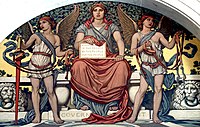
Photo from wikipedia
Purpose Since the 2008 financial crisis the United States has three times implemented quantitative easing policy. The results of the policy, however, were far below all expectations. Furthermore, it flooded… Click to show full abstract
Purpose Since the 2008 financial crisis the United States has three times implemented quantitative easing policy. The results of the policy, however, were far below all expectations. Furthermore, it flooded emerging markets with low-priced dollars. The purpose of this study is to investigate the overall and individual impacts of the policy on emerging markets. Design/methodology/approach This study uses panel data regression model together with the fixed effects model. Also, a unit root test is conducted to check stationary properties of the data, as well as Durbin-Watson statistic to check serial correlation issues in the models. In estimating empirical models this paper employs macroeconomic dataset of stock market returns, exchange rates, lending interest rates, consumer price index, monetary aggregates and foreign exchange reserves from seven diversified emerging economies. The emerging markets in this study include China, Indonesia, Singapore, Hong Kong, Taiwan, Russia and Brazil. The time period und...
Journal Title: International Journal of Emerging Markets
Year Published: 2017
Link to full text (if available)
Share on Social Media: Sign Up to like & get
recommendations!